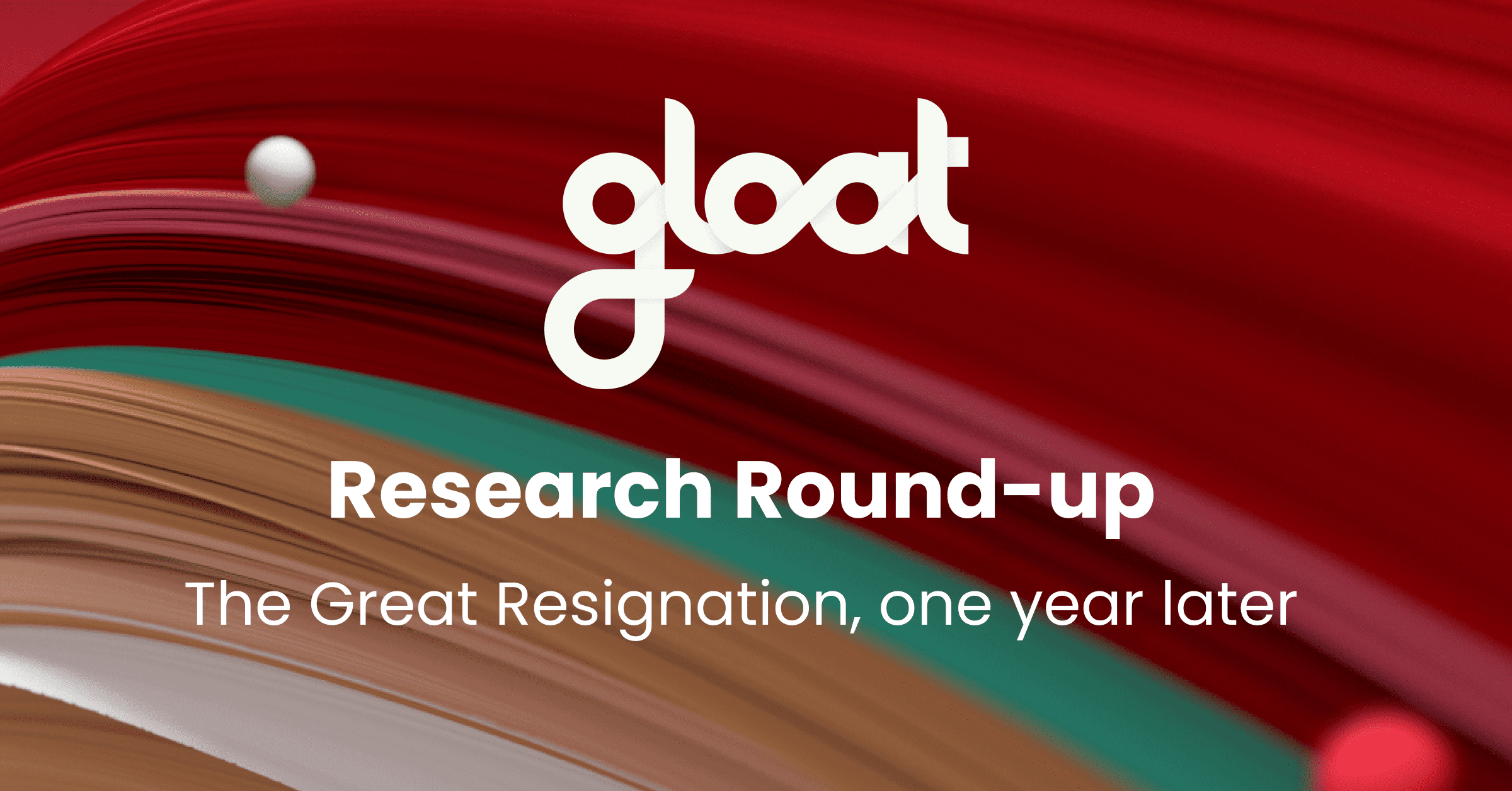April research round-up

What I am reading, listening to, and thinking about in the world of talent marketplaces

By Jeff Schwartz, VP of Insights and Impact at Gloat
This time last year, Anthony Klotz coined a term that quickly went on to dominate news headlines and boardroom discussions: the Great Resignation. The Texas A&M professor hypothesized that the first year of the COVID-19 pandemic would lead to “pent-up resignations”, which data from the Bureau of Labor Statistics quickly proved to be true.
Throughout much of 2021 and 2022, monthly turnover rates surpassed 4 million employees in the United States—and there’s still no sign of a slowdown. In fact, in a recent interview, Klotz said elevated resignation rates will likely continue for years, as Americans reevaluate work and reassess their overarching sense of purpose. In our research at Gloat, we looked behind the headlines of the Great Resignation, (or what Heather Long frames as the Great Reassessment) and saw that 74% of highly skilled workers believe they have better opportunities outside their organizations than inside.
Yet, despite these gloomy forecasts, there are reasons to feel optimistic about what’s to come. COVID-19 and the Great Resignation have presented leaders with a unique opportunity to reinvent work and workplaces. Pioneering organizations that heard the Great Resignation’s call to action and embarked on transformative journeys are already reaping promising results that will inspire others to follow in their footsteps.
Wherever you are in your reimagination process, it’s important to simultaneously celebrate strides towards change and identify the challenges that lie ahead. This month’s research roundup spotlights the game-changing ideas that leaders are embracing to get ahead in our next chapter, as well as some of the hurdles we need to keep on our radar.
READ What’s new in thought leadership about the future of work
Workers Don’t Feel Like a 9-to-5 Job is a Safe Bet Anymore, Harvard Business Review, by Carolyn Ockels, Steve King, and Gene Zaino
Over the past twelve months, there has been a lot of talk about employees leaving. What hasn’t been discussed as much is where they’re going. This Harvard Business Review piece sheds light on a surprising finding: a growing proportion of people believe independent work is more secure than traditional employment. Nearly one-third of employees who left their jobs in the last six months did so to start a new business. The authors examine how the pandemic changed peoples’ perceptions of job security, and offer a few suggestions for how businesses can evolve to give their employees what they’re looking for.
Making Sense of the Future, MIT Sloan Management, by Lynda Gratton
Lynda Gratton introduces a concept that sums up how we can think about the challenges we’re facing: the inward-outward dichotomy. Today, most employees are looking inwards, perhaps more than ever before. As work shifts, they’re building new roles, connections, and routines that come with profound changes to their identity. Simultaneously, employers are keeping a finger on the pulse and grappling with what they need to do differently to retain and engage talent.
Hybrid work is presenting HR leaders with a major conundrum, Human Resource Executive, by Jeanne Meister and Jan Bruce
At this point, hybrid work is no longer a temporary accommodation—it’s a mainstream solution. But that doesn’t mean that leaders have flexible work policies completely figured out. In fact, new research sheds light on some of the complexities that our hybrid reality has created. Most notably, employees still have some uncertainty about how to succeed in this environment. While 32% of workers prefer hybrid accommodations, 43% view in-person work as the best option for career advancement. Now that it’s clear that flexible working is here to stay, leaders must address these discrepancies to ensure all employees are set up for success, regardless of where they’re working from.
As Remote Work Becomes Permanent, Can Manhattan Adapt?, The New York Times, by Dana Rubinstein and Nicole Hong
The permanence of hybrid and remote working will also have a lasting impact on city living, as The New York Times explores. This article showcases how different companies are handling return-to-office debates and highlights how the competitive hiring landscape has paved the way for increased flexibility.
‘The secret to retention’: Culture of continuous learning deemed the biggest incentive for employees to stay at their companies, Worklife.news, by Denny Alfonso
Many leaders are recognizing that access to opportunity sits at the heart of the Great Resignation. If you’re looking for another reason to prioritize employee development, look no further than Linkedin’s annual Workplace Learning Report. According to Linkedin’s VP of Talent Development, Linda Cai, “The secret to retention is to invest in your employees’ career development and create intentional opportunities for career transformation. Companies that excel at internal mobility are able to retain employees for an average of 5.4 years—nearly twice as long as companies that struggle with it, where the average retention span is only 2.9 years.”
Democratizing Transformation, Harvard Business Review, by Marco Iiansiti and Satya Nadella
By now, most leaders know business transformation is necessary for success in the new world of work. Yet many organizations run into roadblocks because they fail to create what the authors of this piece called “a digital innovation mindset and culture.” Based on their research, Iianstit and Nadella found that companies must create synergy in three areas to enable transformation at scale: capabilities, technology, and architecture. They also call out several partners within our Gloat community for the success they’ve had in their transformation journeys, including Unilever and Novartis.
The Search for Relevance in a Time of Change, JoshBersin.com, by Josh Bersin
This blog adds a new word to today’s conversations about navigating workforce change: relevance. Bersin argues that one of the main factors that are fueling the turnover spikes is that we’re all on a never-ending search for relevance. From the employee side, he thinks it comes down to four things: 1) Are you paying people fairly given the inflation? 2) Are you giving people a real opportunity to grow? 3) Are you doing something important? and 4) Are you impacting people’s personal lives?
LISTEN What I’ve been playing on repeat
Stave off attrition with an internal talent marketplace, McKinsey, with Emily Field, Bryan Hancock, and Bill Schaninger
While monthly quit rates remain about as high as when talk of the Great Resignation first began, that doesn’t mean that surging turnover has to be your organization’s reality. In this article and podcast episode from McKinsey, three of their partners explore how talent marketplaces are moving the needle when it comes to workforce retention. They note that upwards of 80% of employees want growth and new opportunities, which is exactly what talent marketplaces will help them find.
The Skills-Based Organization, Capital H: Putting humans at the center of work, with Michael Griffiths, Julie Dervin, and John Boudreau
The shift to becoming a skills-based organization is a crucial component of reimagining work. By putting employees’ capabilities at the heart of talent management strategies, skills-based organizations give their people the flexibility and autonomy that they’re looking for. If you’re eager to learn more about what a skills-based transformation looks like in action, don’t miss this podcast episode with Michael Griffiths, Julie Dervin, and John Boudreau.
Jeff Schwartz, Hack the Future, with Terence Mauri
It was my pleasure to sit down with Hack the Future Lab founder Terence Mauri to discuss the changes we’ve seen over the past two years and how work operating models must adapt to keep pace. In our conversation, we unpack the mindset shifts that leaders must embrace to set their organizations up for success in the new world of work and why no one can afford to waste this once-in-a-lifetime opportunity for reinvention.
The World’s WFH Expert is Confident for Offices, Eat Sleep Work Repeat, with Nick Bloom and Anne Raimondi
The pandemic has given us all a crash course in remote working. But we’ll need true expertise to chart our path forward, which is exactly what Stanford economics professor Nick Bloom shares in his conversation with host Bruce Daisely. Drawing on more than a decade of remote work research, Bloom pinpoints where the sweet spot for hybrid working is right now and explains why a little less freedom and a little more coordination will be crucial.
THINK What research and studies are saying about our path forward
Tech talent tectonics: Ten new realities for finding, keeping, and developing talent, Mckinsey, by Sven Blumberg, Ranja Reda Kouba, Suman Thareja, and Anna Wiesinger
Speaking of skills, the stats around skills gaps are pretty alarming. According to McKinsey, 87% of senior executives say their companies are not adequately prepared to address skills gaps and 61% of HR professionals believe that hiring developers will be their biggest challenge in the years ahead. The authors of this piece offer ten suggestions for attracting talent that prove relevant beyond tech candidates, including excelling at end-to-end talent management and viewing DEI as a strategic necessity.
Skills frameworks fuel skills-based organizations, Deloitte, by Michael Griffiths and Ina Gantcheva
This Deloitte blog sums up today’s greatest challenge simply: “You don’t just need to adapt, you need to adapt quickly and effectively.” A skills-based approach is going to be integral for getting adaptation right. The authors break down the architecture of a skills-based organization (SBO), the frameworks that fuel SBOs, and pinpoint why a common skills taxonomy represents the next frontier.
Anatomy of Work Global Index, Asana
Asana’s Anatomy of Work Global Index is filled with interesting insights into what’s working—and what’s not—for organizations today. Their study of more than 10,000 employees reveals what many leaders believe to be true: we haven’t fully figured out hybrid working just yet. While flexibility with hours and location is a net positive change, it also leads to confusion and an occasional sense of loneliness. According to their research:
- 37% of workers say they don’t have a clear start or finish to their working day—rising to 53% for Gen Z employees
- Employees at medium and large organizations spend 59% of their day on work coordination and only 41% on actual skilled work
- 42% are spending more time on email
- 40% are spending more time on video calls
- 52% are multitasking more during virtual meetings
- 56% feel they need to respond immediately to notifications
- Despite nearly half of employees (47%) finding it easier to concentrate at home, 41% feel more isolated when working remotely
These statistics are an important reminder that when it comes to optimizing hybrid teams, there’s still work to be done.
Great Expectations: Making Hybrid Work Work, Microsoft
Microsoft’s Work Trend Index 2022 reveals additional insights that will help leaders navigate the uncertainty that comes with reimagination. After analyzing survey results from more than 31,000 people, findings reveal an urgent opportunity—and responsibility—for leaders to approach the transition to our new world of work with intention and a growth mindset, or risk being left behind.
Some key statistics include:
- 53% of employees are more likely to prioritize health and wellbeing over work than before the pandemic
52% of Gen Z and - Millennials are likely to consider changing employers this year, up 3% year-over-year
- 50% of leaders say their company already requires, or plans to require, full-time in-person work in the year ahead
- 252% increase in weekly time spent in meetings for the average Teams user since February
ICYMI What I keep coming back to
Reimagining HR: Insights from people leaders, Mckinsey, by Laura Blumenfeld, Neel Gandhi, Asmus Komm, and Florian Pollner
As businesses strive to reimagine work and transform their practices, the function of human resources is undergoing a transformation of its own. In fact, 90% of HR leaders predict significant changes to the HR operating model during the next two to three years. This piece by McKinsey examines some of the ideas that will define HR’s new operating model, including enabling agility and fluidity, organizing around the employee experience, and elevating HR through digitalization. At the pioneering organizations that are furthest along in their transformation journeys, many of these themes are already becoming part of the workplace experience.
Let us know what you would add to our list.






